|
Home
> All Guitars >
JET Guitars
|
Honduras mahogany and white African Korina are
stacked and seasoned. When the moisture content is stable at 9% or
less, they will be turned into bodies for JET Earlewood & Caldera guitars. |
|
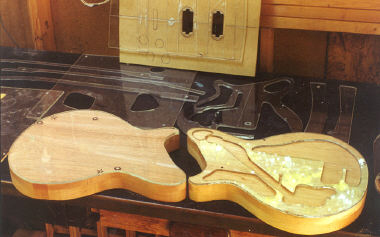 |
The body blanks are planed to thickness, then
shaped with a 7/4" straight bit using the template router guide. In
the background is an array of various templates & patterns.
These blanks are made from the lightest possible Korina or Mahogany
to enhance tone and make these guitars a pleasure to play. |
|
Here's a group of bodies with the tone chambers
routed. We rout chambers using one of three patterns, depending on
the control layout that is going to be used. Chambering gives a nice
resonant character to the guitar and makes them lightweight. Next,
the bodies are planed to produce the proprietary peaked centerline
unique to the JET Earlewood guitar. These are ready to have the tops
joined. |
 |
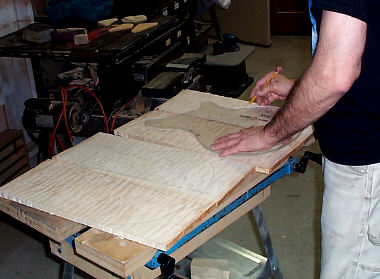 |
The awesome book-matched maple found on our
guitars comes from the Pacific Northwest USA.
These top billets are
actually a hybrid between the beautiful, massive carved tops found
on other high end electric guitars, and the thin tops found on flat
or drop-top makes.
The 1/2 " thick tops Jeff uses give better tone
especially when combined with a maple neck, the top radius preserves
the tasteful sculpted look. |
|
The centerline in the top is carefully jointed by
hand at a precise angle to match the peaked centerline of the body. |
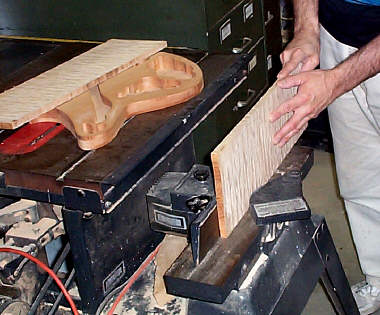 |
 |
Here is an example of the JET proprietary peak,
where you can see the quality and attention to detail that goes into
the construction of each body. |
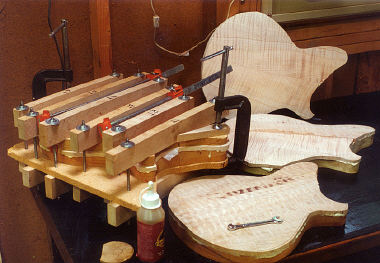 |
Here is a top being glued to a body in the
specially made press in the JET shop. Polyurethane glue, the
strongest wood glue available, is used and cures for at least 24
hours. Also in the photo are two pieces fresh out of the press, and
another that has had the rounded radius sanded into the top after
joining. |
|
Here is a top being glued to a body in the
specially made press in the JET shop. Polyurethane glue, the
strongest wood glue available, is used and cures for at least 24
hours. Also in the photo are two pieces fresh out of the press, and
another that has had the rounded radius sanded into the top after
joining. |
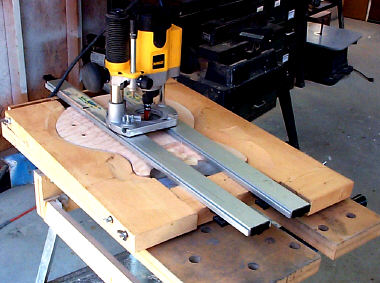 |
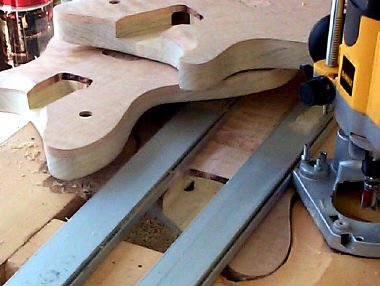 |
This photo shows another view of the neck joint
routing setup, along with a few freshly routed bodies. The pocket
extends more than three inches into the body, and is tight enough to
press in the neck and pick the guitar up with it. |
| With the neck in place but not glued yet, the
pickup cavities are routed using a template guide. The pickups are
direct mounted right into the wood so there are 3 routing steps per
cavity. |
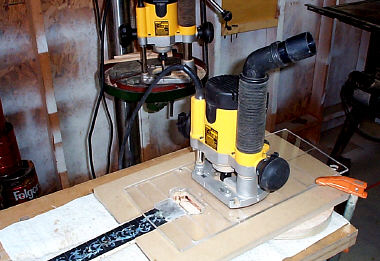 |
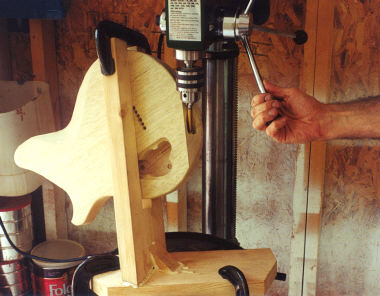 |
The output jack plate is recessed in a bevel. In
order to get the proper compound angles in this tight area, we use a
special fixture for the initial boring. The cavity is then trimmed
by hand. |
|
Earlewood guitars are strung through the body and
over an ebony tailpiece. Perpendicular string holes are bored first. |
 |
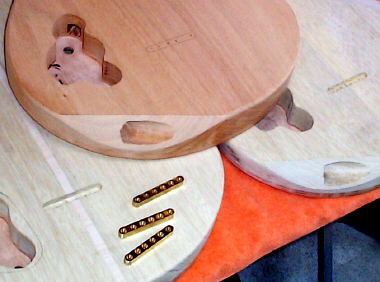 |
The recesses for the ¼" string anchor bar and the
ebony tailpiece are routed using a pattern guide. This photo shows
three partially routed bodies and some string anchors that will be
fit into the recesses. This is also a good view of the jackplate
cavity, which has already been beveled and bored. |
|
One of three alternative control cavity options
is routed. The matching recess for the cover is also created using a
template. The back edge is rounded over also. |
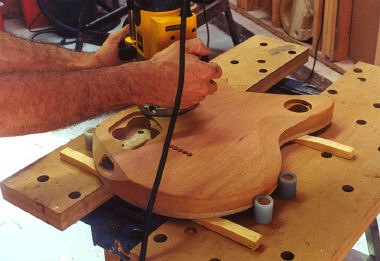 |
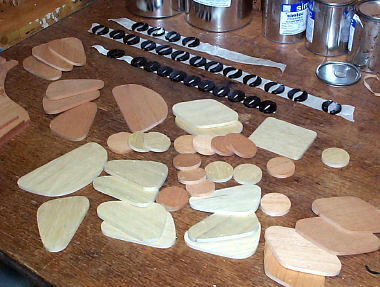 |
Matching recessed korina and mahogany wood covers
are a JET trademark. We make four different ¼" covers using a time
saving method involving plexiglas patterns, coat hanger wire and a
belt sander. (I don't want to give away ALL my trade secrets, now.)
A half day devoted to these yields about two dozen covers. In the
background are some ebony pickup trim pieces. |
|
Here are the bodies fully routed, contoured, and
edge rounded. Now they're ready for final sanding and finishing. You
can see some headstock work in this shot, too. |
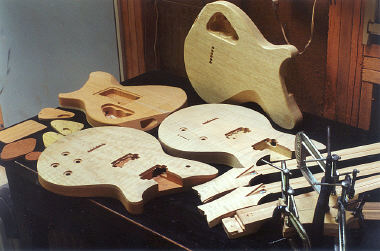 |
|